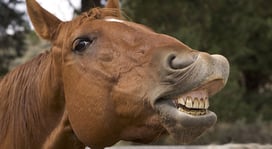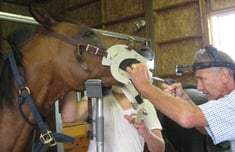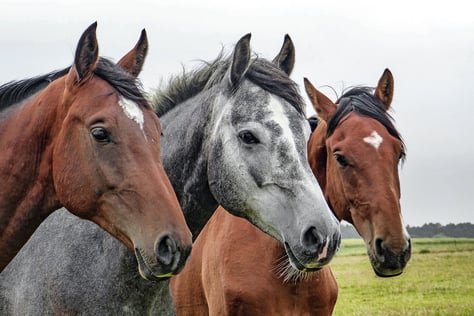 When someone says, “don’t look a gift horse in the mouth,” they are talking about the custom of telling a horse’s age by looking at his teeth. It is possible to estimate the age of a young horse by observing the pattern of teeth in the mouth, based on which teeth have erupted. A horse's incisors, premolars, and molars, once fully developed, continue to erupt as the grinding surface is worn down through chewing. A young adult horse's teeth are typically 4.5–5 inches long, but the majority of the crown remaining below the gum line in the dental socket. The rest of the tooth slowly emerges from the jaw, erupting about 1/8" each year, as the horse ages. When the animal reaches old age, the crowns of the teeth are very short and the teeth are often lost altogether. Differences between breeds and individual horses, however, can make precise dating impossible.
When someone says, “don’t look a gift horse in the mouth,” they are talking about the custom of telling a horse’s age by looking at his teeth. It is possible to estimate the age of a young horse by observing the pattern of teeth in the mouth, based on which teeth have erupted. A horse's incisors, premolars, and molars, once fully developed, continue to erupt as the grinding surface is worn down through chewing. A young adult horse's teeth are typically 4.5–5 inches long, but the majority of the crown remaining below the gum line in the dental socket. The rest of the tooth slowly emerges from the jaw, erupting about 1/8" each year, as the horse ages. When the animal reaches old age, the crowns of the teeth are very short and the teeth are often lost altogether. Differences between breeds and individual horses, however, can make precise dating impossible.
Horses are both heterodontous and diphyodontous, which means that they have teeth in more than one shape (there are up to five shapes of tooth in a horse's mouth), and have two successive sets of teeth, the deciduous ("baby teeth") and permanent sets. By the time a horse is fully developed, usually at around five years of age, it will have between 36 and 44 teeth - mares have 40 permanent teeth and males have 42 permanent teeth. The difference is that males have 2 canine teeth that the female does not have.
All horses have twelve incisors at the front of the mouth, used primarily for cutting food, most often grass, whilst grazing. They are also used as part of a horse's attack or defense against predators, or as part of establishing social hierarchy within the herd. Behind the front incisors is the interdental space, where no teeth grow from the gums. This is where the bit is placed when horses are ridden. Behind the interdental space, all horses also have twelve premolars and twelve molars, also known as cheek teeth or jaw teeth. These teeth chew food bitten off by incisors, prior to swallowing.
Equine teeth are designed to wear against the tooth above or below as the horse chews, thus preventing excess growth. The upper jaw is wider than the lower one. In some cases, sharp edges can occur on the outside of the upper molars and the inside of the lower molars, as they are unopposed by an opposite grinding surface. These sharp edges can reduce chewing efficiency of the teeth, interfere with jaw motion, and in extreme cases can cut the tongue or cheek, making eating and riding painful.
In the wild, a horse’s food supply allowed their teeth to wear evenly. But with domesticated horses grazing on lush, soft forage and a large number being fed grain or other concentrated feed, natural wear may be reduced. Equine dentistry can be undertaken by a vet or by a trained specialist such as an equine dental technician, or in some cases is performed by lay persons, including owners or trainers. Regular checks by a professional are normally recommended every six months or at least annually.
Many horses require floating (or rasping) of teeth once every 12 months, although this, too, is variable and dependent on the individual horse. The first four or five years of a horse's life are when the most growth-related changes occur and hence frequent checkups may prevent problems from developing. Equine teeth get harder as the horse gets older and may not have rapid changes during the prime adult years of life, but as horses become aged, particularly from the late teens on, additional changes in incisor angle and other molar growth patterns often necessitate frequent care. Once a horse is in its late 20s or early 30s, molar loss becomes a concern. Floating involves a veterinarian wearing down the surface of the teeth, usually to remove sharp points or to balance out the mouth.
too, is variable and dependent on the individual horse. The first four or five years of a horse's life are when the most growth-related changes occur and hence frequent checkups may prevent problems from developing. Equine teeth get harder as the horse gets older and may not have rapid changes during the prime adult years of life, but as horses become aged, particularly from the late teens on, additional changes in incisor angle and other molar growth patterns often necessitate frequent care. Once a horse is in its late 20s or early 30s, molar loss becomes a concern. Floating involves a veterinarian wearing down the surface of the teeth, usually to remove sharp points or to balance out the mouth.
Problems with dentition for horses in work can result in poor performance or behavioral issues. However, good dental care can not only eliminate these problems, but can help your horse lead a longer, healthier life.



